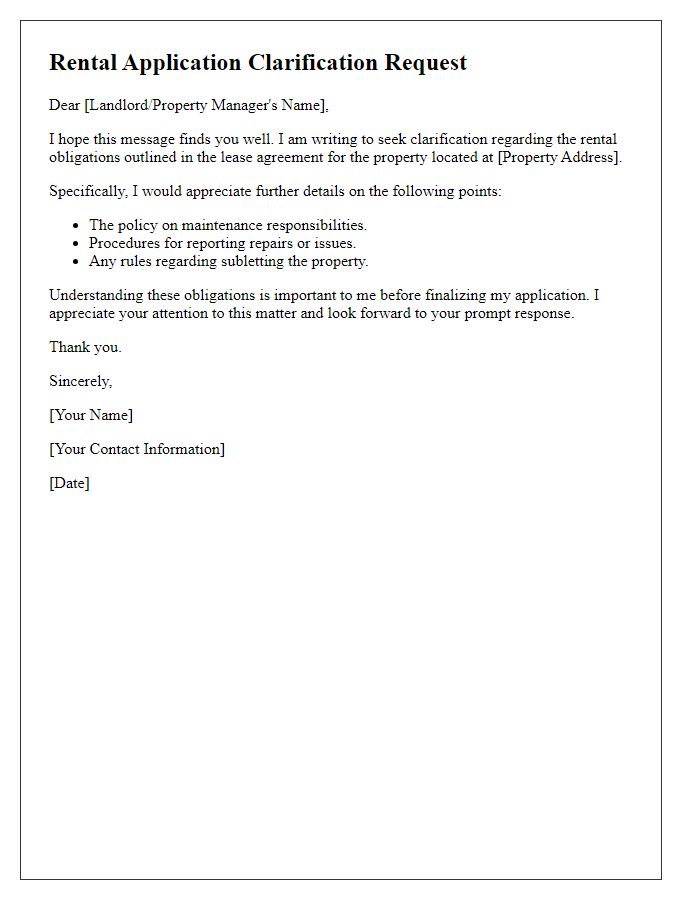Navigating the world of rental applications and lease agreements can sometimes feel overwhelming, especially when it comes to understanding the specific terms laid out by landlords. It's essential to clarify these details to ensure that both parties are on the same page and to avoid any misunderstandings down the line. Knowing your rights and responsibilities as a tenant not only helps in creating a harmonious living environment but also empowers you in your rental journey. So, if you're looking to demystify rental leases and gain clarity on the crucial elements of your next application, read on!

Clear Identification of Parties
When entering into a lease agreement, clear identification of parties is essential for establishing legal responsibilities. The tenant, defined as the individual or entity renting the property, must include their full name, contact information, and identification, such as a driver's license number or social security number. The landlord or property management company must also be explicitly identified, including their legal business name, contact details, and relevant documentation proving ownership of the property or authority to lease. This identification ensures that both parties understand their roles, obligations, and rights under the lease agreement, potentially avoiding disputes during the rental period.
Lease Duration and Renewal Terms
In a rental application context, understanding the lease duration is crucial for both landlords and tenants. Typically, residential leases, such as 12-month agreements, define the length of tenancy, offering stability for occupants in areas like New York City. Renewal terms clarify the options available to renew the agreement upon expiration. For example, automatic renewal clauses may allow the lease to continue indefinitely unless terminated, with notice requirements often varying from 30 to 60 days before the lease end. Additionally, knowing the conditions for early termination, such as job relocation or financial hardship, can affect a tenant's decision regarding the lease. Understanding these terms ensures clear expectations and protections for both parties involved.
Rent Payment Details and Adjustments
The clarification of rent payment details and adjustments is essential for ensuring a smooth rental experience. Rent amounts typically range from $1,000 to $2,500 monthly based on location, size, and amenities of residential properties. Payment schedules often dictate that rent is due on the first day of each month, with a grace period of five days before late fees can be applied. Adjustments may occur due to lease renewals, reflecting changes in market rates or property improvements that can impact overall costs. For tenants, maintaining clear documentation is vital in case adjustments arise, ensuring both parties understand their rights and responsibilities. Additionally, electronic payment options often streamline the process, with many landlords utilizing platforms such as PayPal or direct bank transfers for convenience.
Maintenance and Repair Responsibilities
In rental agreements, maintenance and repair responsibilities are crucial for both landlords and tenants to understand. Typically, landlords are responsible for major repairs related to structural integrity (such as roof leaks and plumbing issues), while tenants handle minor maintenance tasks (like changing light bulbs and regular cleaning). New York City rental laws stipulate that landlords must respond to repair requests within a reasonable time frame, often defined as 30 days for non-emergency issues. Tenants should document requests and maintain records of communication to ensure accountability. Additionally, preventative maintenance measures, such as changing HVAC filters every three months, are often outlined in lease agreements to promote a safe living environment. Proper understanding of these responsibilities helps facilitate a harmonious landlord-tenant relationship and ensures upkeep of the rental property.
Termination and Notice Procedures
Termination of a rental lease agreement typically requires adherence to specific procedures outlined in the rental contract. Standard agreements often stipulate a notice period ranging from 30 to 60 days, depending on local regulations and the terms defined in the lease. For example, tenants in California must provide a minimum of 30 days' notice if they have occupied the property for less than a year, while a 60-day notice is required for longer tenancies. Tenants should ensure written communication is sent via certified mail or other tracked methods to guarantee delivery. This helps establish a clear record of the termination notice. Additionally, any reasons for termination, such as a job relocation or family emergency, should be documented to avoid potential disputes. Understanding these procedures can significantly impact the smooth transition from a rental property and help avoid penalty fees or legal complications.
Letter Template For Rental Application Lease Terms Clarification Samples
Letter template of rental application request for lease agreement details.

Letter template of rental application seeking clarification on lease conditions.

Letter template of rental application for detailed lease term explanation.

Letter template of rental application asking for clarification on rental obligations.

Letter template of rental application to understand lease duration and terms.

Letter template of rental application requesting elaboration on lease clauses.

Letter template of rental application for clarification on deposit requirements.

Letter template of rental application inquiring about rent payment schedule.






Comments